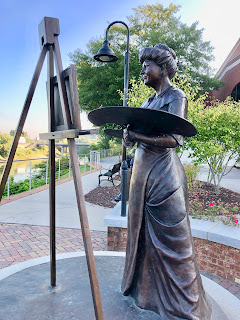As I walked across a bridge spanning the river in Rome, Georgia recently, I looked down at waters not unlike the Bayou Teche in my hometown of New Iberia, Louisiana — they looked a bit muddy. However, I shouldn’t have been surprised because the silt from not one, but three rivers, flows through the area I crossed. The Oostanaula, Etowah, and Coosa Rivers meet in the area of downtown Rome, once center of a thriving cotton industry.
In its early formation, this town was visited by Hernando DeSoto and was occupied by Cherokee Indians who called it “Enchanted Land.” Early settlers named the city Rome after the Italian city with seven hills on the Tiber River, as the site in Georgia also boasts seven prominent hills above the city.
We had been attracted to this city while searching for a Little Theater production within a few hours’ drive of Sewanee, Tennessee, and had discovered a matinee performance of Alice in Wonderland at the DeSoto Theater on Broad Street, Rome’s main thoroughfare. The play, based on Lewis Carroll’s book, was an adaptation that featured an all-youth cast. The youngest actors and actresses were fifth graders, the oldest actress was a dual-enrolled college student, and among them were talented home schoolers.
Lindsey Chambers, director of the production, instructed this group in a master’s class that featured vocal work, diction, volume, character development, and intense script analysis, and the students rehearsed three months for their parts. Rylee Barfield as the Mad Hatter, became my favorite. Prior to the performance, I had read an article about the references to drugs in Alice in Wonderland, purporting that Lewis Carroll had been an opium addict, but I suppose highly imaginative authors who create fantastical characters in other-world settings frequently get bad press. Readers of Carroll’s world who allude to him as a drug user probably wouldn’t have liked the cover of the Rome performance: “We Are All Mad Here.”
Rome’s largest contribution to American education, from the 18th century to present-day, remains Berry College, an institution made famous by Martha Berry, a wealthy planter’s daughter who began to teach indigent children in her playhouse cabin near her home, and whose efforts resulted in a Boys Industrial School and the Martha Berry School for Girls. Later, with contributions from Andrew Carnegie and Henry Ford, the Berry Junior College was established and expanded into a four year institution. Today, Berry College is the largest landmass college in the world with over 28,000 acres and 2,000 undergraduate and graduate students.
I was amused at a story in a Rome visitor’s guide about the Captoline Wolf, a bronze statue of a wolf reputed to have been a gift to the City of Rome from Italian Dictator Benito Mussolini, which has been correctly identified as a gift from Francesco Boncompagni Ludovisi, the governor of Rome, Italy. Copies of the original, located in Rome, Italy are also found in Rome, New York; Cincinnati, Ohio; Brasilia, Brazil; and other sites around the world.
We photographed a statue of Woodrow Wilson’s wife, Ellen, who spent her childhood in Rome, Georgia and set up a scholarship at Berry College for underprivileged mountain children. During her years as First Lady, Ellen laid out the famous Rose Garden at the White House and wrote a bill to better the living conditions for slum areas around Washington DC. She is buried at Myrtle Hill Cemetery in Rome.
A list of notables who lived in Rome includes a literary find for me: Calder Willingham, Jr. I was browsing in Dogwood Books and Antiques on Broad Street and discovered a display of this author who lived in Rome and whose father owned a hotel on Broad Street. Willingham was once dubbed the father of contemporary dark comedy and was well-known among postwar novelists such as Norman Mailer, James Jones, Truman Capote who were important in the literary scene of Greenwich Village.
I had never read any of Willingham's work, but I picked up a copy of The Girl in Dogwood Cabin and began to read it. Last night I watched “Rambling Rose,” the movie script Willingham wrote for one of his novels. He was widely recognized for his work on the script for “The Graduate” also, and his novel, Eternal Fire, set in his native Rome, Georgia, established him as a major writer. Shelby Foote hailed him as “the only living American writer qualified to hold Doestoevsky’s coat in a street fight.” Sadly, Willingham is now regarded as an under-sung American novelist and screen writer whose works are mostly found in rare and second-hand bookstores.
Rome has also become a mecca for national industries such as Mohawk, Sara Lee, Kellogg, Suzuki and other commercial businesses. It’s another one of Georgia’s small cities that has preserved its heritage, particularly the buildings on Broad Street that are painted the colors of buildings in the French Quarter of New Orleans, Louisiana: bright yellow, green, pink, lavender colors that accentuate the beautiful 19th century architecture.
P.S. It’s an ideal sized city with a population that equals my hometown of New Iberia, Louisiana.
















No comments:
Post a Comment